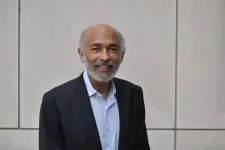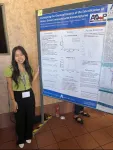(Press-News.org) The degree to which a surgical patient’s subconscious processing of pain, or “nociception,” is properly managed by their anesthesiologist will directly affect the degree of post-operative drug side effects they’ll experience and the need for further pain management they’ll require. But pain is a subjective feeling to measure, even when patients are awake, much less when they are unconscious. In a new study, MIT and Massachusetts General Hospital (MGH) researchers describe a set of statistical models that objectively quantified nociception during surgery. Ultimately, they hope to help anesthesiologists optimize drug dose and minimize post-operative pain and side effects.
The new models integrate data meticulously logged over 18,582 minutes of 101 abdominal surgeries in men and women at MGH. Led by former MIT graduate student Sandya Subramanian, now an assistant professor at UC Berkeley and UC San Francisco, the researchers collected and analyzed data from five physiological sensors as patients experienced a total of 49,878 distinct “nociceptive stimuli” (such as incisions or cautery). Moreover, the team recorded what drugs were administered, and how much and when, to factor in their effects on nociception or cardiovascular measures. They then used all the data to develop a set of statistical models that performed well in retrospectively indicating the body’s response to nociceptive stimuli.
The team’s goal is to furnish such accurate, objective, and physiologically principled information in real-time to anesthesiologists who currently have to rely heavily on intuition and past experience in deciding how to administer pain-control drugs during surgery. If anesthesiologists give too much, patients can experience side effects ranging from nausea to delirium. If they give too little, patients may feel excessive pain after they awaken.
“Sandya’s work has helped us establish a principled way to understand and measure nociception (unconscious pain) during general anesthesia,” said study senior author Emery N. Brown, Edward Hood Taplin Professor of Medical Engineering and Computational Neuroscience in The Picower Institute for Learning and Memory, the Institute for Medical Engineering and Science, and the Department of Brain and Cognitive Sciences at MIT. Brown is also an anesthesiologist at MGH and a Professor at Harvard Medical School. “Our next objective is to make the insights that we have gained from Sandya’s studies reliable and practical for anesthesiologists to use during surgery.”
Surgery and statistics
The research, published in The Proceedings of the National Academy of Sciences, began as Subramanian’s doctoral thesis project in Brown’s lab in 2017. The best prior attempts to objectively model nociception have either relied solely on the electrocardiogram (ECG, an indirect indicator of heart-rate variability) or other systems that may incorporate more than one measurement, but were either based on lab experiments using pain stimuli that do not compare in intensity to surgical pain or were validated by statistically aggregating just a few time points across multiple patients’ surgeries, Subramanian said.
“There’s no other place to study surgical pain except for the operating room,” Subramanian said. “We wanted to not only develop the algorithms using data from surgery, but also actually validate it in the context in which we want someone to use it. If we are asking them to track moment-to-moment nociception during an individual surgery, we need to validate it in that same way.”
So she and Brown worked to advance the state of the art by collecting multi-sensor data during the whole course of actual surgeries and by accounting for the confounding effects of the drugs administered. In that way, they hoped to develop a model that could make accurate predictions that remained valid for the same patient all the way through their operation.
Part of the improvements the team achieved arose from tracking patterns of heart rate and also skin conductance. Changes in both of these physiological factors can be indications of the body’s primal “fight or flight” response to nociception or pain, but some drugs used during surgery directly affect cardiovascular state, while skin conductance (or “EDA,” electrodermal activity) remains unaffected. The study measures not only ECG but also backs it up with PPG, an optical measure of heart rate (like the oxygen sensor on a smartwatch), because ECG signals can sometimes be made noisy by all the electrical equipment buzzing away in the operating room. Similarly, Subramanian backstopped EDA measures with measures of skin temperature to ensure that changes in skin conductance from sweat were because of nociception and not simply the patient being too warm. The study also tracked respiration.
Then the authors performed statistical analyses to develop physiologically relevant indices from each of the cardiovascular and skin conductance signals. And once each index was established, further statistical analysis enabled tracking the indices together to produce models that could make accurate, principled predictions of when nociception was occurring and the body’s response.
Nailing nociception
In four versions of the model, Subramanian “supervised” them by feeding them information on when actual nociceptive stimuli occurred so that they could then learn the association between the physiological measurements and the incidence of pain-inducing events. In some of these trained versions she left out drug information and in some versions she used different statistical approaches (either “linear regression” or “random forest”). In a fifth version of the model, based on a “state space” approach, she left it unsupervised, meaning it had to learn to infer moments of nociception purely from the physiological indices. She compared all five versions of her model to one of the current industry standards, an ECG-tracking model called ANI.
Each model’s output can be visualized as a graph plotting the predicted degree of nociception over time. ANI performs just above chance but is implemented in real time. The unsupervised model performed better than ANI, though not quite as well as the supervised models. The best performing of those was one that incorporated drug information and used a “random forest” approach. Still, the authors note, the fact that the unsupervised model performed significantly better than chance suggests that there is indeed an objectively detectable signature of the body’s nociceptive state even when looking across different patients.
“A state space framework using multisensory physiological observations is effective in uncovering this implicit nociceptive state with a consistent definition across multiple subjects,” wrote Subramanian, Brown and their co-authors. “This is an important step toward defining a metric to track nociception without including nociceptive ‘ground truth’ information, most practical for scalability and implementation in clinical settings.”
Indeed the next steps for the research are to increase the data sampling and to further refine the models so that they can eventually be put into practice in the operating room. That will require enabling them to predict nociception in real-time, rather than in post-hoc analysis. When that advance is made, that will enable anesthesiologists or intensivists to inform their pain drug dosing judgements. Further into the future, the model could inform closed-loop systems that automatically dose drugs under the anesthesiologist’s supervision.
“Our study in an important first step toward developing objective markers to track surgical nociception,” the authors concluded. “These markers will enable objective assessment of nociception in other complex clinical settings, such as the ICU, as well as catalyze future development of closed-loop control systems for nociception.”
In addition to Subramanian and Brown, the paper’s other authors are Bryan Tseng, Marcela del Carmen, Annekathryn Goodman, Douglas Dahl and Riccardo Barbieri.
Funding from The JPB Foundation, The Picower Institute for Learning and Memory, George J. Elbaum (MIT '59, SM '63, PhD '67), Mimi Jensen, Diane B. Greene (MIT, SM '78), Mendel Rosenblum, Bill Swanson, Cathy and Lou Paglia, annual donors to the Anesthesia Initiative Fund, the National Science Foundation and an MIT Office of Graduate Education Collabmore-Rogers Fellowshipsupported the research.
END
Research quantifying “nociception” could help improve management of surgical pain
New statistical models based on rigorous physiological data from more than 100 surgeries provide objective, accurate measures of “nociception,” the body’s subconscious perception of pain
2024-09-23
ELSE PRESS RELEASES FROM THIS DATE:
How cranes navigate their complex world
2024-09-23
The researchers used tiny GPS tracking devices to follow the movements of 104 cranes in Africa, Asia, and Europe. These devices included unique solar-powered GPS leg bands developed by scientists from MPI-AB. The tracking data revealed the impressive migrations that cranes undertook. Some of the migratory routes exceeded 6,400 km of travel round trip and required crossing barriers such as the Alps or Himalaya mountain ranges, the deserts of the Arabian peninsula, or the Mediterranean Sea. In addition to the tracking study, the researchers also developed a statistical framework that revealed how the cranes’ movements relate to aspects of the ...
New origami-inspired system turns flat-pack tubes into strong building materials
2024-09-23
Engineers at RMIT University have designed an innovative tubular structural system that can be packed flat for easier transport and pop up into strong building materials.
This breakthrough is made possible by a self-locking system inspired by curved-crease origami — a technique that uses curved crease lines in paper folding.
Lead researchers, Dr Jeff (Ting-Uei) Lee and Distinguished Professor Mike (Yi Min) Xie, said bamboo, which has internal structures providing natural reinforcement, inspired the tube design.
“This self-locking system is the result of an intelligent geometric design,” said Lee from RMIT’s School of Engineering. ...
Low gravity in space travel found to weaken and disrupt normal rhythm in heart muscle cells
2024-09-23
Johns Hopkins Medicine scientists who arranged for 48 human bioengineered heart tissue samples to spend 30 days at the International Space Station report evidence that the low gravity conditions in space weakened the tissues and disrupted their normal rhythmic beats when compared to earth-bound samples from the same source.
The scientists said the heart tissues “really don’t fare well in space,” and over time, the tissues aboard the space station beat about half as strong as tissues from the same source kept on Earth.
The findings, ...
New approach to defibrillation may improve cardiac arrest outcomes
2024-09-23
Joshua Lupton, M.D., has no memory of his own cardiac arrest in 2016. He only knows that first responders resuscitated his heart with a shock from a defibrillator, ultimately leading to his complete recovery and putting him among fewer than one in 10 people nationwide who survive cardiac arrest outside of a hospital.
He attributes his survival to the rapid defibrillation he received from first responders — but not everybody is so fortunate.
Now, as lead author on a new observational study published in the journal JAMA Network Open, he and co-authors from Oregon Health & Science University ...
UTA undergraduate researcher wins state honor
2024-09-23
A student studying biological chemistry at The University of Texas at Arlington earned a state-wide award for her research on diazo compounds, the building blocks of some medications. Jenny Hoang, a senior, received the third-place award at the 2024 University of Texas System Louis Stokes Alliance for Minority Participation (LSAMP) conference held in El Paso in August.
“Honestly, I was so shocked that I won third place because I almost didn’t even apply for this program,” said Hoang, a Carrollton ...
Novel method detects biological oxidant derived from CO2 in cells
2024-09-23
High levels of carbon dioxide (CO2) in the atmosphere can alter not only the climate of our planet but also the functioning of our cells. The gas interacts with hydrogen peroxide (H2O2), which performs various functions in the human body, giving rise to a potent oxidant called peroxymonocarbonate.
"More and more evidence is emerging that peroxymonocarbonate is important in both cells’ adaptive responses via redox signaling and in cellular dysfunction. There is also epidemiological evidence that the levels of CO2 our cities are close to reaching cause a number of physiological problems. And the mechanisms underlying the toxicity of CO2 are ...
American Cancer Society experts presenting key research at 2024 ASCO Quality Care Symposium
2024-09-23
Scientists from the American Cancer Society (ACS) are presenting research studies at the 2024 Annual Meeting of the American Society of Clinical Oncology (ASCO) Quality Care Symposium (QCS) September 27-28 in San Francisco, CA. ASCO QCS offers research and education that encompasses the needs and viewpoints of multiple disciplines and various practice settings, attracting oncology professionals from around the world. This year’s program will feature studies complementing the meeting’s theme: “Driving Solutions, Implementing ...
New research identifies critical gaps in mental health care for adults with schizophrenia spectrum disorders
2024-09-23
New research finds that adults with schizophrenia spectrum disorders have high rates of comorbid mental and substance use disorders and significant social and economic disadvantages, and only 26% received minimally adequate treatment. Meeting the needs of people with schizophrenia spectrum disorders will require innovative interventions and implementation to improve access to and use of evidence-based approaches, the authors argue. The research was published today in Psychiatric Services in Advance.
The researchers, led by Natalie Bareis, Ph.D., ...
Advances in theranostics take center stage at SNMMI 2024 Therapeutics Conference
2024-09-23
Reston, VA (September 23, 2024)—More than 300 nuclear medicine clinicians, researchers, technologists, regulators and suppliers gathered in Bethesda, Maryland, on September 19-21, for the Society of Nuclear Medicine and Molecular Imaging (SNMMI) 2024 Therapeutics Conference. As the largest SNMMI Therapeutics Conference to date, the meeting offered attendees the chance to explore the latest innovations and advancements in theranostics and other nuclear medicine therapies as well as gain valuable insights into enhancing their practice.
This year’s Therapeutics Conference included eight distinct sessions covering advances in radiopharmaceutical ...
Firms that withdrew from Russia following Ukraine invasion earn higher consumer sentiment
2024-09-23
Following Russia’s 2022 invasion of Ukraine, many companies with operations in Russia withdrew from or severely curtailed their Russian operations. For example, Dell and McDonald’s ceased all operations in Russia after the invasion.
Many experts have argued that the corporate response to the Ukraine war is a striking example of stakeholder capitalism, a model where corporations are responsible for considering the interests of various stakeholders — including employees, customers, communities, governments and the environment — and not just ...
LAST 30 PRESS RELEASES:
Quantum simulator sheds light on how nature moves energy in systems like photosynthesis and solar conversion
Can a hashtag help prevent atrocities? Study shows social media can be a powerful tool
The American Ornithological Society (AOS) announces the winner of the 2025 Wesley Lanyon Award
Woolly rhino genome recovered from Ice Age wolf stomach
An earthquake on a chip: New tech could make smartphones smaller, faster
New research shows how AI tools are expanding individual capabilities while contracting scientific attention
A nanomaterial flex — MXene electrodes help OLED display technology shine, while bending and stretching
Global research team uncovers mechanism by which metabolites guide cellular decisions
Work hours, stress, and burnout among resident physicians
Quality of life of parents of premature infants
Should younger and older people receive different treatments for the same infection?
Scientists discover how fast the world’s deltas are sinking
Scientists demonstrate first-time use of AI for genetic circuit design
Copenhagen researchers make the front page of Nature: Solving the mystery of the universe's ‘little red dots’
Seoul National University-Drexel University team achieves world's highest efficiency fully stretchable OLEDs with 17% external quantum efficiency
Hydrogel cilia set new standard in microrobotics
Application of orthogonal CNOP-I in a convection-allowing ensemble prediction system based on CMA-MESO for improving extreme precipitation skill
Study suggests bamboo has ‘superfood’ potential
Hidden heart-care gaps among Asian American patients
Blood test predicts which patients with lung cancer will benefit from newly approved immunotherapy drug
SwRI’s Dr. Michael Davis named SPIE Fellow
Exposure to “forever chemicals” linked to higher risk of gestational diabetes, major review finds
Insilico Medicine integrates Nach01 Foundation Model with Microsoft Discovery to enable AI-native, enterprise-ready drug discovery workflows
New study reveals precursors for forecasting summer clustered extreme precipitation events in Northeast China
A bacterial toxin can counteract colorectal cancer growth
Frozen hydrogen cyanide ‘cobwebs’ offer clues to origin of life
Physics of foam strangely resembles AI training
Bis-pseudoindoxyls: a new class of single benzene-based fluorophores for bioimaging applications
Blocking a cancer-related pathway helps reduce spine deformities due to genetic disorder, finds new study
New study explores therapeutic potential of CRISPRCas3 genome-editing system
[Press-News.org] Research quantifying “nociception” could help improve management of surgical painNew statistical models based on rigorous physiological data from more than 100 surgeries provide objective, accurate measures of “nociception,” the body’s subconscious perception of pain









